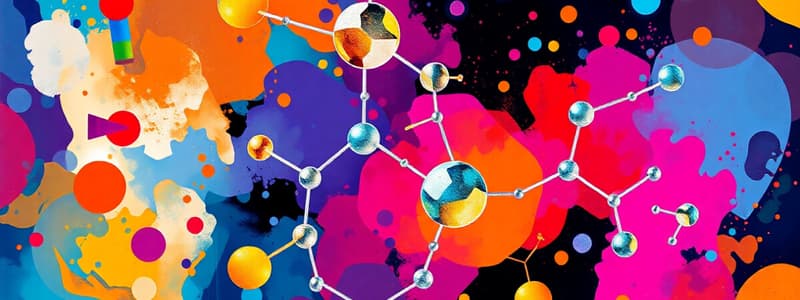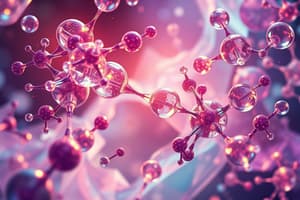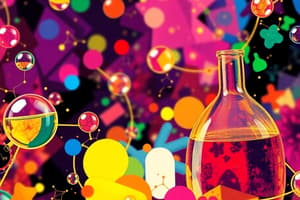Podcast
Questions and Answers
What is the primary goal of pharmaceutical and medicinal chemistry?
What is the primary goal of pharmaceutical and medicinal chemistry?
- Synthesizing chemical compounds
- Developing medications for treating diseases (correct)
- Analyzing drug interactions
- Studying existing drugs
What does the initial step of drug discovery and development involve?
What does the initial step of drug discovery and development involve?
- Preclinical studies
- Target identification and validation (correct)
- Lead optimization
- Clinical trials
What does SAR, or Structure-Activity Relationship, primarily examine?
What does SAR, or Structure-Activity Relationship, primarily examine?
- The economic costs of drug synthesis.
- The correlation between a drug's chemical structure and its pharmacological activity. (correct)
- The interaction of drugs with food.
- The effect of advertising on drug sales.
What is the purpose of preclinical studies in drug development?
What is the purpose of preclinical studies in drug development?
What does pharmacokinetics (PK) describe?
What does pharmacokinetics (PK) describe?
What is the process by which a drug enters the bloodstream called?
What is the process by which a drug enters the bloodstream called?
Which process refers to how a drug spreads throughout the body?
Which process refers to how a drug spreads throughout the body?
What term describes the body's chemical modification of a drug?
What term describes the body's chemical modification of a drug?
The removal of a drug from the body is known as what?
The removal of a drug from the body is known as what?
Why is understanding pharmacokinetics (PK) crucial in drug development?
Why is understanding pharmacokinetics (PK) crucial in drug development?
What type of interactions do drugs typically use to bind to biological targets?
What type of interactions do drugs typically use to bind to biological targets?
What is a pharmacophore?
What is a pharmacophore?
Lipinski's Rule of Five predicts what property of a drug?
Lipinski's Rule of Five predicts what property of a drug?
What is a prodrug?
What is a prodrug?
What do agonists do to receptors?
What do agonists do to receptors?
What is the function of enzyme inhibitors?
What is the function of enzyme inhibitors?
What is a common limitation of oral drug delivery?
What is a common limitation of oral drug delivery?
What does combinatorial chemistry allow for?
What does combinatorial chemistry allow for?
Where do many drugs originate from or get their inspiration?
Where do many drugs originate from or get their inspiration?
What does rational drug design involve?
What does rational drug design involve?
Flashcards
Medicinal Chemistry
Medicinal Chemistry
Designing, developing, and synthesizing new drugs; studying existing drugs, their properties, and interactions within the body.
Target Identification
Target Identification
The first step in drug development: identifying a molecule or pathway in the body linked to a disease.
Lead Optimization
Lead Optimization
Modifying a lead compound's chemical structure to improve its potency and selectivity, enhancing drug-like properties.
Structure-Activity Relationship (SAR)
Structure-Activity Relationship (SAR)
Signup and view all the flashcards
Drug Metabolism
Drug Metabolism
Signup and view all the flashcards
Absorption
Absorption
Signup and view all the flashcards
Distribution
Distribution
Signup and view all the flashcards
Metabolism
Metabolism
Signup and view all the flashcards
Excretion
Excretion
Signup and view all the flashcards
Pharmacophore
Pharmacophore
Signup and view all the flashcards
Lipinski's Rule of Five
Lipinski's Rule of Five
Signup and view all the flashcards
Prodrug
Prodrug
Signup and view all the flashcards
Receptors
Receptors
Signup and view all the flashcards
Agonists
Agonists
Signup and view all the flashcards
Antagonists
Antagonists
Signup and view all the flashcards
Enzyme Inhibitors
Enzyme Inhibitors
Signup and view all the flashcards
Drug Delivery Systems
Drug Delivery Systems
Signup and view all the flashcards
Organic synthesis
Organic synthesis
Signup and view all the flashcards
Rational Drug Design
Rational Drug Design
Signup and view all the flashcards
Immunotherapies
Immunotherapies
Signup and view all the flashcards
Study Notes
- Pharmaceutical and medicinal chemistry are disciplines at the intersection of chemistry and pharmacology involved with designing, developing, and synthesizing new drugs.
- These fields study existing drugs, their biological properties, and their interactions with the body.
- The ultimate goal is to develop safe and effective medications for treating diseases
Drug Discovery and Development
- Target identification and validation are the initial steps, identifying a specific molecule or pathway in the body associated with a disease.
- Once a target is selected, researchers seek compounds that can interact with it.
- High-throughput screening (HTS) tests large compound libraries for activity against the target.
- Lead optimization involves modifying a lead compound's chemical structure to improve its potency, selectivity, and pharmacokinetic properties.
- Preclinical studies are conducted in vitro and in vivo to assess the safety and efficacy of the drug candidate.
- Clinical trials are conducted in humans to evaluate the safety and efficacy of the drug candidate.
Structure-Activity Relationship (SAR)
- SAR studies examine the relationship between a drug's chemical structure and its pharmacological activity.
- Modifying a drug's chemical structure can alter its binding affinity, selectivity, and efficacy.
- SAR optimizes drug properties, reduces side effects, and improves overall therapeutic potential.
- Quantitative structure-activity relationship (QSAR) uses statistical methods to correlate chemical structure with biological activity.
Drug Metabolism and Pharmacokinetics
- Drug metabolism, or biotransformation, is the process by which the body chemically modifies a drug.
- Cytochrome P450 enzymes are a major class of enzymes involved in drug metabolism.
- Pharmacokinetics (PK) describes the movement of drugs within the body, including absorption, distribution, metabolism, and excretion (ADME).
- Absorption refers to the process by which a drug enters the bloodstream.
- Distribution refers to the process by which a drug spreads throughout the body.
- Metabolism refers to the process by which a drug is chemically modified by the body.
- Excretion refers to the process by which a drug is removed from the body.
- Understanding PK is crucial for determining a drug's appropriate dose and dosing frequency.
Drug Design Principles
- Drugs interact with biological targets, such as receptors or enzymes, via non-covalent interactions like hydrogen bonds, hydrophobic interactions, and van der Waals forces.
- A pharmacophore is the three-dimensional arrangement of atoms or functional groups responsible for a particular biological activity.
- Lipinski's Rule of Five predicts whether a chemical compound with a certain pharmacological or biological activity has properties that would make it a likely orally active drug in humans.
- Lipinski's rule states that, in general, an orally active drug has: no more than 5 hydrogen bond donors, no more than 10 hydrogen bond acceptors, a molecular mass less than 500 daltons, and an octanol-water partition coefficient (log P) not greater than 5.
Prodrugs
- A prodrug is a medication administered in an inactive or less active form.
- Once administered, the prodrug is metabolized in the body into an active drug.
- Prodrugs are designed to improve drug bioavailability, stability, or targeting.
- Converting a drug into a prodrug can improve membrane permeability.
- Prodrugs can be activated by enzymes, pH, or other physiological conditions.
Receptors and Drug Action
- Receptors are proteins located on the surface or within cells that bind to specific molecules, such as drugs or hormones, triggering a cellular response.
- Agonists bind to receptors and activate them, producing a biological effect.
- Antagonists bind to receptors and block the binding of agonists, preventing a biological effect.
- Receptor selectivity is the ability of a drug to bind to a specific receptor subtype, minimizing off-target effects.
- Understanding receptor pharmacology is essential for designing drugs with specific therapeutic effects.
Enzyme Inhibitors
- Enzymes are proteins that catalyze biochemical reactions in the body.
- Enzyme inhibitors bind to enzymes and decrease their activity.
- Enzyme inhibitors can be used to treat a variety of diseases.
- Competitive inhibitors bind to the same site on the enzyme as the substrate, while non-competitive inhibitors bind to a different site.
- Transition state inhibitors are particularly potent because they mimic the transition state of the enzymatic reaction.
Drug Delivery Systems
- Drug delivery systems are formulations or devices used to administer drugs to the body.
- Oral delivery is the most common route of administration, but it can be limited by poor bioavailability or drug degradation in the gastrointestinal tract.
- Parenteral delivery involves injecting drugs directly into the bloodstream or tissues, providing rapid and complete bioavailability.
- Transdermal delivery involves applying drugs to the skin for absorption into the bloodstream.
- Targeted drug delivery systems deliver drugs specifically to the site of action, minimizing systemic side effects.
- Nanoparticles, liposomes, and other carriers can be used to improve drug delivery.
Chemical Synthesis in Medicinal Chemistry
- Organic synthesis is a core skill in medicinal chemistry, involving the creation of new molecules with desired structures and properties.
- Combinatorial chemistry allows for the rapid synthesis of large numbers of related compounds.
- Solid-phase synthesis involves attaching a molecule to a solid support and carrying out reactions on the support.
- Stereoselective synthesis is used to create molecules with specific stereochemistry, which can be important for drug activity.
- Efficient synthetic routes are essential for producing drugs on a large scale.
Natural Products as Drug Leads
- Natural products are compounds produced by living organisms, such as plants, microorganisms, and animals.
- Many drugs are derived from natural products or are inspired by their structures.
- Natural products often have complex and unique structures, providing a rich source of drug leads.
- Isolation, identification, and characterization of active compounds from natural sources are crucial steps in drug discovery.
- Traditional medicine has long been a source of natural product drug leads.
Rational Drug Design
- Rational drug design involves designing drugs based on knowledge of the target's structure and function.
- Computer-aided drug design (CADD) uses computational methods to predict drug-target interactions and optimize drug properties.
- Structure-based drug design uses the three-dimensional structure of the target to design drugs that fit into the binding site.
- Ligand-based drug design uses information about known active compounds to design new drugs.
- Molecular docking, molecular dynamics simulations, and bioinformatics tools are used in rational drug design.
Immunotherapies
- Immunotherapies harness the power of the immune system to fight diseases like cancer.
- Immune checkpoint inhibitors block proteins that prevent the immune system from attacking cancer cells.
- Monoclonal antibodies can target specific proteins on cancer cells, marking them for destruction by the immune system.
- Cell-based therapies, such as CAR-T cell therapy, involve modifying a patient's immune cells to target cancer cells.
- Immunotherapies have shown promise in treating a variety of cancers.
Gene Therapy
- Gene therapy involves introducing genetic material into cells to treat or prevent disease.
- Viral vectors are commonly used to deliver genes into cells.
- Gene editing technologies, such as CRISPR-Cas9, allow for precise modification of genes.
- Gene therapy holds promise for treating genetic disorders, cancer, and infectious diseases.
Personalized Medicine
- Personalized medicine involves tailoring medical treatment to the individual characteristics of each patient.
- Pharmacogenomics studies how genes affect a person's response to drugs.
- Genetic testing can identify individuals who are likely to benefit from a particular drug or who are at risk of adverse effects.
- Personalized medicine aims to optimize drug efficacy and minimize side effects.
Studying That Suits You
Use AI to generate personalized quizzes and flashcards to suit your learning preferences.




